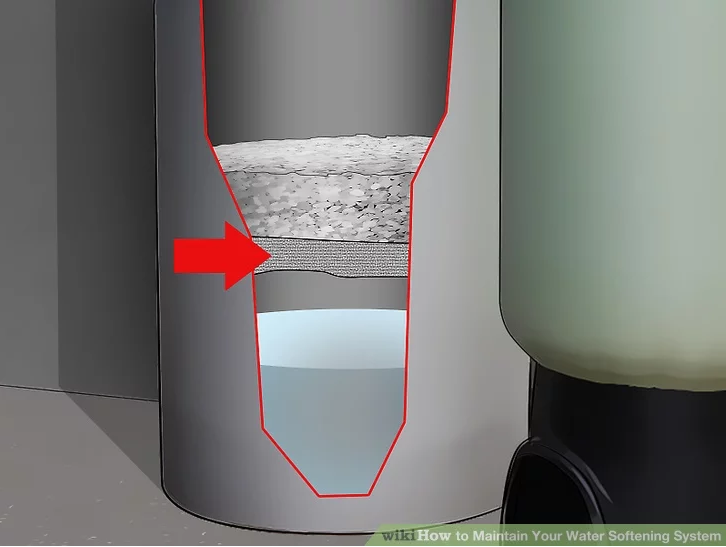My Water Softener Continues to Get Salt Bridges
One of the benefits of modern technology is that home water softening systems have become more efficient, cutting down on salt and water usage. An efficient water softener uses the precise amount of brine, requiring fewer regenerations. Less waste eases the strain on the environment and lowers the cost of softening water for homeowners. During regeneration, resin is flooded with brine water to flush hardness minerals down the drain. As a result of a brine tank kept at optimal level for regeneration, the salt in a tank is motionless for longer periods of time.

In areas of high humidity, where water softeners are often housed, the combination of humidity and standing salt water often causes the formation of salt bridges. A salt bridge is simply a hard crust that has developed over the water in your brine tank causing improper regeneration. If you've noticed your water has suddenly become hard, or brine isn't being produced and your water softener has stopped using salt, your tank may have developed a salt bridge.
Salt is a necessary part of the ion exchange process. Salt-based water softening, using the process of ion exchange, is the only way to effectively eliminate hard water. Your water softener's brine tank should be checked regularly and cleaned as needed. When salt bridges, an empty space forms between the water and the salt in your tank. When this happens, the water that enters the tank from the bottom doesn't reach the salt. The salt will not dissolve to make brine, and without brine, a water softener's resin bed will not regenerate, resulting in hard water and no salt usage.
Salt-based water softeners are the only way to eliminate hard water. The impurities and trace minerals nearly always found in salt can contribute to build-ups and clumping. This can't always be avoided, but using high purity salt will leave less storage tank residue, lowering the likelihood of salt bridging and salt mushing.
Removing Salt Bridges From The Tank
Salt bridging is a common problem and one that most DIY homeowners can easily tackle. First, turn off the water to your softening system or use the bypass valve. Find a blunt tool with a long handle, like a broom or mop, and turn it upside, handle first, into your tank. Tap the center of the salt bridge with the handle until it breaks and falls into the tank. Continue to break apart at the salt crust until the entire bridge is cleared, including any remaining salt along the edges.
When chipping away at the bridge, be careful not to puncture or crack the tank. Some tanks have platforms at various heights, so never use more force than necessary. The deeper the salt level in the tank, the more tedious it is to remove, but tapping away gently at the salt should be enough to cause it to crumble. Breaking the salt bridge, and not the tank is the goal.
As you go along, scoop and remove any loose chunks of salt at the surface. Pour some warm water to clean and dissolve any stubborn salt from the bridge remaining at the bottom of the tank. When all has been cleared, take your softener out of bypass and consult your owner's manual to begin a new regeneration process. Regenerate until all the salt in the tank has been cleared. Then add fresh salt and let the water softener operate as usual.
Is Your Salt at Fault?
If salt bridges become a recurring issue, it could be that the salt you're using is of poor quality. Not all salt is the same-- it comes in all shapes, sizes and purity levels. Salt with the highest purity levels is truly soluble, meaning it's easily dissolved in water, and a better choice for your system. High purity salt treats your hard water and extends the lifespan of your equipment. When choosing salt, consideration should be given to water hardness levels, softener design, and household water usage. For long-lasting and consistent water softening, consult your user manual for the manufacturer's salt recommendation.
Proper leveling of salt is just as important the type of salt you place inside your tank. To ensure your water softener will provide perfectly softened water for your household, never overfill or replenish too frequently. Keep your brine tank at least a quarter full of salt, and no more than 6 inches below the top of the brine tank. Your salt level should remain a few inches above the water level.
Always use salt specifically designed for home water softening systems. Evaporated salt is the purest form of sodium-based salt used for softening water, and is the least likely to cause bridging. Look for reputable brands to supply your salt and shop around for good deals. When you use high purity salts, like Morton's System Saver Pellets, found here on Amazon or Pure and Natural Softener Salt, here, or Diamond Crystal's Bright and Soft, you will likely dodge many of the salt issues that appear inside a softener's brine tank, as well as eliminate the buildup that hard water can leave inside your pipes and appliances.
Avoid cheap salt that won't effectively remove hardness ions and can cause frequent maintenance. The more hard water minerals your system eliminates the better your water will perform during everyday household use. Using the right salt gives your water softening equipment the advantage it needs to provide an uninterrupted flow of high-quality, softened water throughout your home.
Source: https://www.discountwatersofteners.com/what-is-a-water-softener-salt-bridge-and-how-to-fix-it/
Post a Comment for "My Water Softener Continues to Get Salt Bridges"